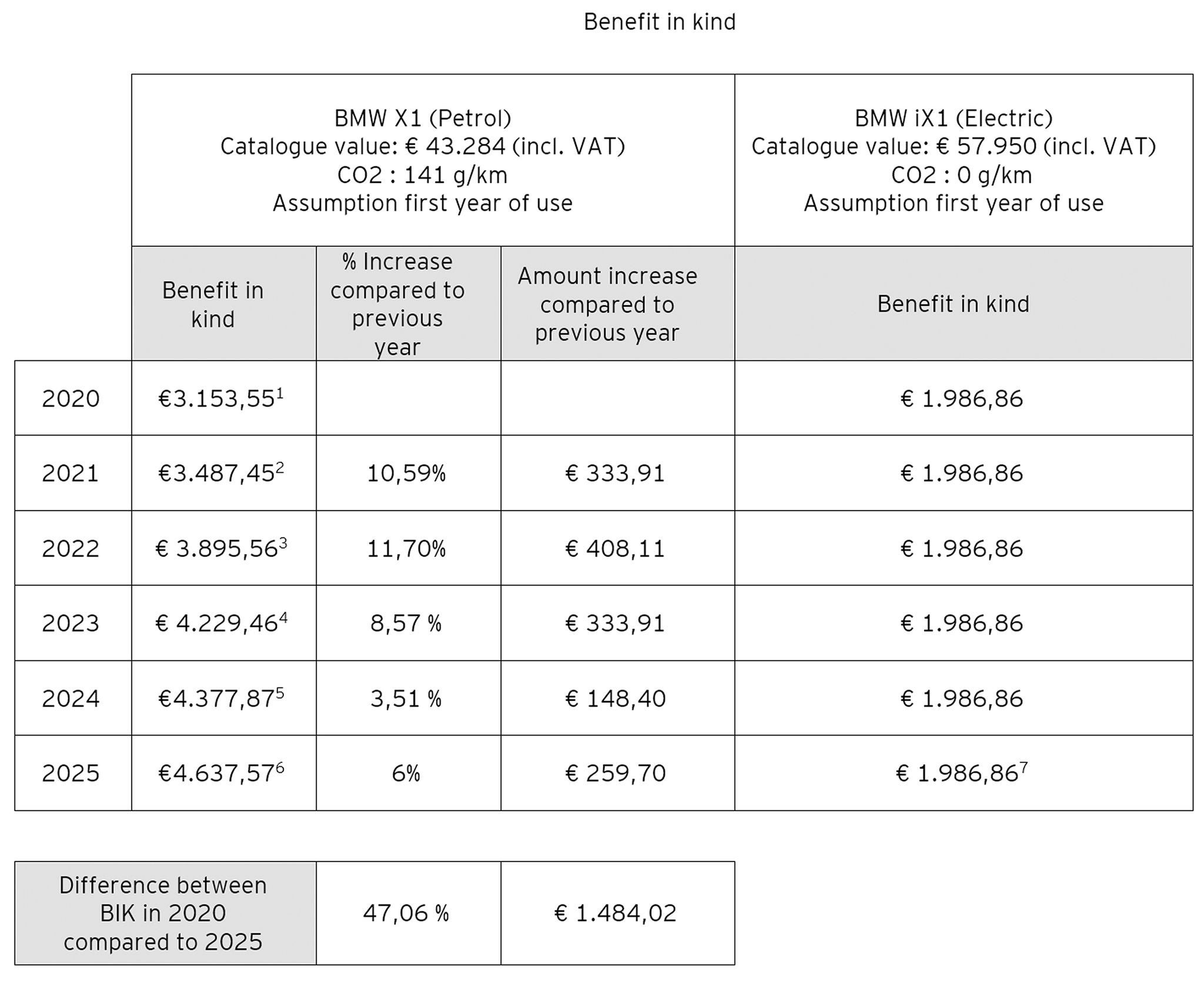EY refers to the global organization, and may refer to one or more, of the member firms of Ernst & Young Global Limited, each of which is a separate legal entity. Ernst & Young Global Limited, a UK company limited by guarantee, does not provide services to clients.

Starting January 1, 2025, individuals driving combustion company cars who also use it for private purposes will experience an increase in the benefit in kind. This change is due to the recently updated reference CO2-emission values that will take effect at the beginning of the year.
This alert will briefly outline the changes to the benefit in kind for company cars in 2025 and their impact on your employees.
An increase of the benefit in kind for (combustion) company cars
The taxable benefit in kind (i.e. the value on which the taxes for the car are calculated) is calculated based on the following factors: the catalogue value, the age coefficient, the fuel type, and the CO2 -coefficient.
The CO2-coefficient is one of the central elements in the calculation of this benefit in kind and the difference between the CO2-emmission of the company car and the reference CO2-emmission determines the increase or decrease of the CO2-coefficient ant thus the reported benefit in kind.
The reference CO2-emmission is determined on a yearly basis, depends on the fuel type of the car (diesel engine versus petrol, LPG- natural gas engine), is based on the average CO2-emmission of newly subscribed cars during a reference period and cannot be higher than the reference CO2-emmission of the previous income year. As a result, if the Belgian vehicle fleet becomes less CO2 pollutant during the reference period, the applicable (maximum) reference CO2-emission will decrease accordingly. Hence, this will result in an increase of the taxable benefit in kind for the private use of a company car.
Recently, the reference CO2-emission values for income year 2025 have been issued through a Royal Decree.
Reference CO2 emission for 2025
Based on the Royal Decree, the (maximum) reference CO2-emission values as from January 1st, 2025, are the following:
- Petrol, LPG- or natural gas engine: 71 g/km (in 2024: 78 g/km)
- Diesel engine: 59 g/km (in 2024: 65 g/km)
For electric cars the determination of the benefit in kind is different as there is no C02-emission for these cars. Therefore the CO2-coefficient for electrical cars is fixed at 4%. Thus, no formula with actual CO2-emission and reference CO2-emission will be applicable.
Additionally, the minimum benefit in kind has not yet been published. For 2024, the minimum amount was 1.600 EUR per year, but this will be subject to indexation for income year 2025.
Evolution of the benefit in kind since 2020
As shown in the example below, the taxable benefit in kind for the private use of a company car will increase in 2025 compared to 2024 for combustion cars. Each time the Belgian vehicle fleet will become greener overall, the employees with a non-electric company car will see an additional increase of their benefit in kind. If the current trend continues and more electric company cars are introduced, taxes on combustion cars are likely to keep increasing.
The benefit in kind of a BMW X1 (petrol) with a catalogue value of € 43.284 (incl. VAT) and a CO2-emission of 141 g/km has increased with 47% since 2020. Taxes are also applicable to electric cars, but the amount remains stable since their emissions are always zero.
The significant increase of the benefit in kind does not only negatively impact the employee, but also the employer. A higher benefit in kind will lead to a higher Total Cost of Ownership (TCO) and higher corporate taxes.
To ensure a fair comparison over the years, our example assumes the first year of use (i.e., the same car being ordered each time in 2020, 2021, etc.) and does not consider the age coefficient. The age coefficient would reduce the benefit in kind (BIK), potentially shielding some drivers from the impact of the reference CO2-emission changes. Consequently, the increase in BIK only becomes apparent when one opts for a new company car and continues to choose a combustion model.

1 =6/7 * 43.284 * (5,5 + (141-111)*0,1)%
2 =6/7 * 43.284 * (5,5 + (141-102)*0,1)%
3 =6/7 * 43.284 * (5,5 + (141-91)*0,1)%
4 =6/7 * 43.284 * (5,5 + (141-82)*0,1)%
5 =6/7 * 43.284 * (5,5 + (141-78)*0,1)%
6 =6/7 * 43.284 * (5,5 + (141-71)*0,1)%
7 =6/7 * 57.950 * 4%
Key takeaways
As the greening trend of vehicles (inclusive of both company and private cars) continues, the yearly reference CO2-value is expected to diminish progressively. This decline will in turn prompt a corresponding rise in the benefit in kind for combustion cars and thus will lead to higher taxes. Therefore, the transition to electrified company car fleets will persist.
If you want to know more about the mobility transformation and the way to set up a green mobility policy, don’t hesitate to contact your EY contact.
